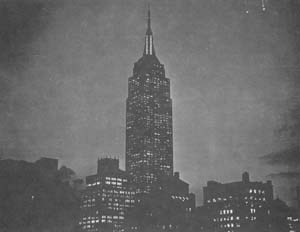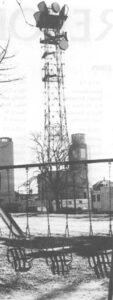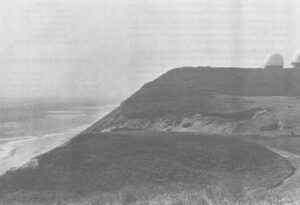 Last June, when the Bureau for Radiation Control of the New York City Department of Health announced its intention to establish a standard for environmental exposure to radio frequency and microwave radiation, a collective shudder passed through the radio and television broadcast industry. As well it might. The Bureau’s proposed standard called for a radiation power level of no more than 50 microwatts per square centimeter “in unregulated or uncontrolled areas available to men, women and children by virtue of residence, recreation, or general public access.” Now, 50 microwatts is not only a power level 200 times less than the level presently considered safe by the federal government for workers and people in the general population, it is also a power level that can commonly be found in the vicinity of FM radio and TV transmitters from one end of the United States to the other. For example, in its ongoing survey of broadcast radiation levels in American cities, the federal Environmental Control Agency has measured 66 microwatts in the Sears Tower, in Chicago; 97 microwatts at 2 Biscayne Boulevard, in Miami; 100 microwatts in high rise buildings near the Sutro Tower broadcast complex, in San Francisco; and 150 microwatts at the base of a radio transmitter tower in Portland, Oregon.
Last June, when the Bureau for Radiation Control of the New York City Department of Health announced its intention to establish a standard for environmental exposure to radio frequency and microwave radiation, a collective shudder passed through the radio and television broadcast industry. As well it might. The Bureau’s proposed standard called for a radiation power level of no more than 50 microwatts per square centimeter “in unregulated or uncontrolled areas available to men, women and children by virtue of residence, recreation, or general public access.” Now, 50 microwatts is not only a power level 200 times less than the level presently considered safe by the federal government for workers and people in the general population, it is also a power level that can commonly be found in the vicinity of FM radio and TV transmitters from one end of the United States to the other. For example, in its ongoing survey of broadcast radiation levels in American cities, the federal Environmental Control Agency has measured 66 microwatts in the Sears Tower, in Chicago; 97 microwatts at 2 Biscayne Boulevard, in Miami; 100 microwatts in high rise buildings near the Sutro Tower broadcast complex, in San Francisco; and 150 microwatts at the base of a radio transmitter tower in Portland, Oregon.
Since the EPA has unaccountably chosen to conduct more than 99% of its radiation measurements at street level-which, as anyone who has ever tried to play a car radio in the canyons of New York City knows, is hardly the place to get any kind of reception, let alone make accurate measurements-the broadcast radiation levels in American cities are undoubtedly much higher than either the government or the broadcast industry knows or would like to admit.
Proof of this was demonstrated in February of 1977, when the National Institute for Occupational Safety and Health measured one full milliwatt of radiation (a level 20 times as great as the one being proposed in New York, and an intensity believed by many scientists to have adverse biological effects) on the seventh floor of The New York Times building on 43rd street, just west of Seventh Avenue. According to the NIOSH report, “it was concluded that the meter was responding either to radio station WQXR located on the 9th floor of the Times Building or to signals from a nearby television station… ” Interestingly, the Times has never seen fit to mention the NIOSH finding in any of the news it deems fit to print. As a result, very few of its employees are in view of the situation, it was hardly surprising that the broadcast industry (accompanied by legal counsel and paid consultants) showed up in force, on October 5th, at a public hearing on New York’s proposed radio frequency and microwave radiation standard, which was held by the city’s Board of Health. During a marathon session that began in the morning and lasted into the afternoon, dozens of people went to the front of the hearing room to speak for or against the regulations. A statement read on behalf of Louis J. Lefkowitz, Attorney General of the State of New York, commended the Bureau for its action, claimed that “the residents of New York City are being bombarded with microwaves at increasing rates,” and pointed out that research conducted on animals here and abroad showed that exposure to microwaves can cause central nervous system aberrations, cataracts, blood abnormalities, leukemia, changes in brain function, and genetic damage.” On the other hand, Deputy Mayor Peter J. Solomon, while commending the Health Department for its “attentiveness to this issue,” warned that “if the proposed regulation is adopted it will have a negative impact on television broadcasting operations and disrupt an industry of major significance to New York City’s economy.”
 How, one wondered, could a chief aide of Mayor Koch be so solicitous of the economic health of a particular industry, when the essential question being posed at the public hearings concerned the health of the human residents of the city, who, presumably, had elected the mayor to look after their best interests? The answer to that question was not long in coming as, one after the other, representatives of the various broadcast corporations trooped to the microphones to inform the members of the Board of Health that they had, in effect, made an error of gargantuan proportions in even presuming to consider the proposed environmental standard. The TV Broadcasters All Industry Committee-an organization made up of the eight commercial TV broadcasters, WNET, and the city’s municipal broadcasting system told the board that if the regulations were adopted they would “radically diminish the geographic area and viewing audience covered by television and radio broadcasting emanating from either the Empire State Building or the World Trade Center,” and that “substantially all of the viewers who are now experiencing satisfactory reception… would suffer a recognizable degradation of their picture in the form of ‘snow,’ and that substantially all of the viewers who are now receiving a limited amount of snow would experience a very heavy amount or a total loss of the picture. ” If this impending catastrophe were not enough to make the members of the Board of Health wonder how in the name of Gotham they had got them selves into such a predicament with the TV Broadcasters All Industry Committee had an additional arm twisting reminder-a point so telling that it seemed to hover palpably above the swamp that separates the woods of persuasion from the grove of blackmail. Surely, the committee went on, the members of Mayor Koch’s Board of Health could not be unaware that “five people holding appointive office are considering a law which if adopted could conceivably change the pattern of life in and around New York City.”
How, one wondered, could a chief aide of Mayor Koch be so solicitous of the economic health of a particular industry, when the essential question being posed at the public hearings concerned the health of the human residents of the city, who, presumably, had elected the mayor to look after their best interests? The answer to that question was not long in coming as, one after the other, representatives of the various broadcast corporations trooped to the microphones to inform the members of the Board of Health that they had, in effect, made an error of gargantuan proportions in even presuming to consider the proposed environmental standard. The TV Broadcasters All Industry Committee-an organization made up of the eight commercial TV broadcasters, WNET, and the city’s municipal broadcasting system told the board that if the regulations were adopted they would “radically diminish the geographic area and viewing audience covered by television and radio broadcasting emanating from either the Empire State Building or the World Trade Center,” and that “substantially all of the viewers who are now experiencing satisfactory reception… would suffer a recognizable degradation of their picture in the form of ‘snow,’ and that substantially all of the viewers who are now receiving a limited amount of snow would experience a very heavy amount or a total loss of the picture. ” If this impending catastrophe were not enough to make the members of the Board of Health wonder how in the name of Gotham they had got them selves into such a predicament with the TV Broadcasters All Industry Committee had an additional arm twisting reminder-a point so telling that it seemed to hover palpably above the swamp that separates the woods of persuasion from the grove of blackmail. Surely, the committee went on, the members of Mayor Koch’s Board of Health could not be unaware that “five people holding appointive office are considering a law which if adopted could conceivably change the pattern of life in and around New York City.”
And so it went. The All Industry Committee was supported by the National Association of Broadcasters, who warned that unwarranted fear of radiation “communicated in an emotional manner to Government officials can easily prompt action which would be contrary to the interests of the public, as is the case with the subject proposal”. The position of the Association was, in turn, more or less buttressed by arguments set forth by RKO General, Inc., the Electronics Industries Association, the ABC Radio Network, and WCBS-TV. As it happened, CBS was the only network station to actually cover the proceedings. Indeed, CBS sent its veteran science editor and reporter, Earl Ubell, who did a series of post-hearing interviews with people on both sides of the issue. However, a funny thing happened to Ubell’s footage on the way to the six o’clock news that night. None of it got there. Neither, for that matter, did Ubell. Instead, Jim Jensen appeared on the screen and delivered an account of the hearings that contained not a word about any of the voluminous testimony given concerning the adverse biological effects of microwaves, but that waxed eloquent about the terrible threat to TV reception that was in the making.
By blatantly managing the news in this fashion, WCBS not only missed an opportunity to cover the microwave controversy in an objective manner, but blinded by the myopia of self-interest, also managed to miss the one truly human story of the day. This occurred about midway in the hearings, when a diminutive, white-haired lady appeared before the microphones and addressed the members of the Board of Health in a voice that was firm with conviction, yet quick with the nervousness of someone obviously unaccustomed to speaking in public. “My name is Nettie Yannon,” she said. “I am from Staten Island. I have no speech prepared. I wish you gentlemen and members of the committee had been here twenty years ago. Perhaps my husband would have been alive today. I am only here for the sake of future generations. My husband was exposed to radiation for fifteen years. He was up in the Empire State Building, and only I and members of my family know what it does to the body. I urge you strongly to look into this matter more deeply.”
What virtually no one in the hearing room knew, but what CBS could easily have discovered, if it had chosen to do so, Was that Nettie Yannon’s husband, Samuel Yannon, an employee of the New York Telephone Company, had worked as a maintenance man on the battery of network television transmitters, including those of CBS, which broadcast in all directions from the 87th floor of the Empire State Building. CBS could have learned, if it had been motivated by the spirit of inquiry on this occasion, that the case of Samuel Yannon is presently being heard before the State of New York Workmen’s Compensation Board. By examining the hearing record, CBS could have found out that, according to his physician, in the years immediately preceding his death, which occurred at the age of fifty-eight, Samuel Yannon’s cognitive function, attention, memory, and judgment had been so impaired that, “He was unable to perform even the most elementary tasks, such as writing his name.” CBS could also have ascertained rather easily that the physician’s diagnosis of Yannon’s ailment appears on the compensation hearing record as “Chronic Brain Syndrome with psychotic overtones, due to biological brain changes resulting from prolonged exposure to heavy doses of short wave radiation.”
Further perusal of the compensation hearing record would have furnished CBS with testimony that an untold number of other New York Telephone employees, who maintained the transmitting equipment on the 87th floor, were also exposed to microwave radiation for lesser periods of time than Samuel Yannon. CBS could then have posed the question essential to any intelligent study of occupational environmental disease, whether it be caused by radiation, chemical contamination, or asbestos. The network could have asked-as the City’s Board of Health should now ask-just how far out from the Empire State Building to the epidemiological ripples of microwave induced sickness extend? What, for example, has been the health experience of Samuel Yannon’s colleagues on the 87th floor? What is the health experience of people working a bit farther from those transmitters-say, down on the 86th floor observation deck? What of the people living and working in high-rise buildings on line of sight with the microwave and radio frequency transmissions from the Empire State Building? And why, if there is nothing to worry about, did they shut down the 107th floor observation deck, a few years ago, and replace all the glass in it with special glass designed to reflect radiation?
Yes, CBS could have asked all these questions, and, since there were no newspapers being published in New York at that time, could have performed a valuable public service. Instead, CBS used Jim Jensen as an unwitting mouthpiece to express a purely corporate point of view. In any case, New Yorkers might be well advised to keep a skeptical eye on any news items about the health effects of microwaves that emanate from their TV screens. People with vested interests inevitably have a tendency to omit embarrassing details. They conveniently forget the Samuel Yannons of this world, hoping that the public will slumber on.
In the meantime, from the top of the Empire State Building, high above New York…
©1978 Paul Brodeur
PAUL BRODEUR’s Fellowship study is on Microwave Radiation.



